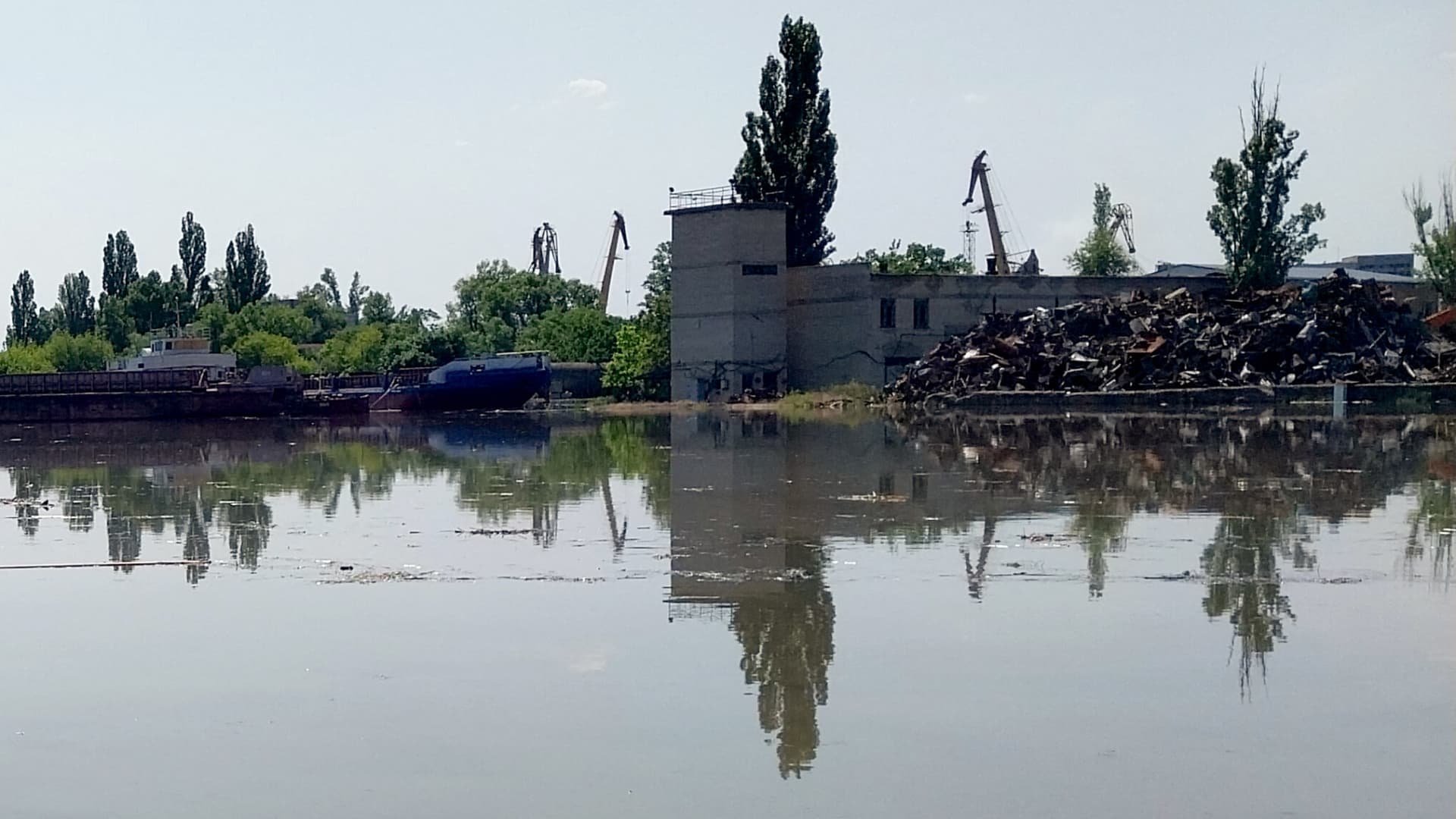This was CNBC’s live blog tracking developments on the war in Ukraine. See here for the latest updates.
Emergency evacuations are underway in parts of the southern Ukrainian region of Kherson as a major incident unfolds following damage to the Kakhovka Hydroelectric Power Plant dam.
Images and videos posted on social media by Ukraine President Volodymyr Zelenskyy and other officials show a massive surge of water heading through the damaged structure, putting thousands of residents downstream at risk.
Ukraine said the dam had been “blown up” by Russian forces Tuesday, with the South command of Ukraine’s Armed Forces saying that “the scale of the destruction, the speed and volume of water, and the probable areas of flooding are being clarified.”
Ukrainian officials warned of potentially devastating flooding in the Kherson region and said around 1,300 people have been evacuated so far.
Russia denied damaging the dam, saying instead that Ukraine had undermined the structure. Vladimir Leontiev, the Russian-installed mayor of Nova Kakhovka, the city where the dam is located, said “night attacks” on the facility had “led to the destruction of the valves” and that “water from the Kakhovka reservoir began to uncontrollably be discharged downstream,” according to Russian state news agency Tass.
CNBC and NBC News have not been able to independently verify Ukraine’s or Russia’s claims about how the dam was initially damaged.
Ukrainian President Volodymyr Zelenskyy called the attack on the Kakhovka dam an “ecological bomb of mass destruction” in a nightly address.
Zelenskyy thanked first responders for helping to evacuate people from the region and for assisting in other humanitarian efforts, such as providing clean drinking water, according to an NBC News translation of his address.
“Such deliberate destruction by the Russian occupiers of the dam and other structures of the [Kakhovka Hydroelectric Power Plant] HPP is an ecological bomb of mass destruction,” Zelenskyy said on his official Telegram channel.
“It is very important now to take care of each other and help as much as possible. The whole world will know about this Russian war crime, the crime of ecocide,” he said, according to an NBC News translation.
Zelenskyy also said that Ukraine’s prosecutor general “appealed to the Office of the Prosecutor of the International Criminal Court to involve international justice in investigating the dam explosion.”
— Amanda Macias
The White House said it was working with allies to provide Ukraine additional assistance following the destruction of the Kakhovka dam in the Kherson region.
“The immediate focus is rightly on all the Ukrainians whose lives and towns and villages are affected by this flooding and making sure that they have the aid and assistance that they need,” National Security Council spokesman John Kirby told reporters at the White House.
Kirby added that it was “too soon to assess what kind of impact this is going to have on the battlefield.” He also said the U.S. is working with Ukraine to gather additional information about what happened.
— Amanda Macias
Young Ukrainian cadets attended a mass military education camp on Tuesday in Kyiv, Ukraine.
Four hundred Ukrainian youths in the State Lyceum “Cadet Corps” competed in various timed and skill events, including competitions in tactical medical training and reconnaissance missions. They had to quickly collect weapons, descend into bomb shelters and put on anti-radiation and anti-chemical equipment. A field kitchen was also available for the children.
— Getty Images
The following Maxar satellite images show the damaged Kakhovka dam in southern Ukraine, which Kyiv and Moscow have blamed each other for. The attack on the dam in the Kherson region has led to rising floodwaters and the evacuation of more than 1,300 people from the area.
— Amanda Macias
Britain’s Foreign Secretary James Cleverly (C) operates an unmanned de-mining vehicle as he visits members of the Halo Trust non-commercial charity organization for de-mining, as he watches operations in the village of Hrebelky, east of Kyiv.
Valentyn Ogirenko | AFP | Getty Images
United Nations Secretary-General Antonio Guterres said attacks on critical civilian infrastructure have to stop, as thousands flee the Kherson region following an attack on the Kakhovka dam.
Guterres told reporters at the United Nations that the U.N. does not have independent information on what unfolded but said, “One thing is clear, this is another devastating consequence of the Russian invasion of Ukraine.” He did not take any questions.
“Massive flooding, large-scale evacuations, environmental devastation, destruction of newly planted crops and added threats to the highly threatened Zaporizhzia nuclear power plant — Europe’s largest nuclear facility,” he said.
He called the act a “monumental humanitarian, economic and ecological catastrophe” and said the U.N. is rushing to provide clean drinking water for the area.
— Amanda Macias
NATO Secretary General Jens Stoltenberg slammed the attack on the Kakhovka dam in southern Ukraine on Twitter.
“This is an outrageous act, which demonstrates once again the brutality of Russia’s war in Ukraine,” the NATO chief wrote, adding that the attack puts “thousands of civilians at risk.”
More than 1,000 people have been evacuated from the rising floodwaters in the area, according to Ukrainian rescue services.
— Amanda Macias
Chicago wheat was trading higher Tuesday morning amid heightened supply worries after the Kakhovka Hydroelectric Power Plant dam in southern Ukraine was blown up.
Ukraine’s grain production has fallen sharply since Russia invaded the country last year and its grain yields could fall by 20% if current dry and hot weather persists, according to a Reuters report on Monday.
The government has said its grain harvest could decline to 44.5 million metric tons in 2023. In comparison, grain output decreased to around 53 million metric tons in 2022 from a record 86 million metric tons in 2021, according to Reuters.
— Melodie Warner
Ukrainian President Volodymyr Zelenskyy met with Cardinal Matteo Zuppi, the special envoy tapped by Pope Francis to work on a peace plan for Russia’s ongoing conflict in Ukraine.
Zelenskyy said the two met in Kyiv and discussed the battlefield situation, humanitarian efforts, war crimes and additional ways to apply pressure on Russia.
“I call on the Holy See to contribute to the implementation of the Ukrainian peace plan. Ukraine welcomes the readiness of other states and partners to find ways to peace, but since the war is on our territory, the algorithm for achieving peace can be Ukrainian only,” Zelenskyy wrote on his official Telegram channel.
In a separate readout from Kyiv, Zuppi gave Zelenskyy a letter from Pope Francis.
— Amanda Macias
Two ships carrying a combined total of 68,100 metric tons of wheat left Ukraine’s ports of Chornomorsk and Odesa under the Black Sea Grain Initiative.
The ships are destined for Turkey and Bangladesh, according to the U.N.-backed organization overseeing the export activity.
Russia, Ukraine, the United Nations and Turkey agreed to extend the Black Sea grain deal on May 16 for another two months. Since mid-May, 24 ships have sailed under the agreement carrying a combined total of 990,114 metric tons of agricultural products.
— Amanda Macias
Ukraine said around 1,300 people have been evacuated so far, as flooding affects the Kherson region following severe damage to the Kakhovka hydroelectric power plant dam in the Russian-controlled town of Nova Kakhovka.
Ukraine’s emergency services, police and volunteers are involved in the evacuations, with around 80 settlements downstream at risk of flooding and a number reporting rapidly rising water levels.
The dam had held back 18 cubic kilometres (4.3 cubic miles) of water — a volume roughly equal to the Great Salt Lake in Utah, Reuters noted.
Ukraine’s Minister of Internal Affairs Ihor Klymenko said in his latest comments that 24 settlements have been flooded so far, as a surge of water flooded through the dam.
“We expect that the water level will be increasing within next 24 hours, so all departments will work around the clock,” he said on Telegram, according to a Google translation.
The Russian-installed Mayor of Nova Kakhovka said water levels in the town had risen above 11 meters.
Ukraine and Russia accuse each other of creating a man-made disaster by damaging the dam in the early hours of Tuesday morning, and of continuing to attack the area.
“Even after today’s terrorist attack, the Russian occupiers continue to shell the territory where evacuation measures are being carried out. And such shelling continues at this very moment,” Klymenko said.
Moscow alleged Ukraine “sabotaged” the dam to hurt Russian-occupied Crimea’s water supply and to cover up military failures. Ukraine denied this, saying Moscow had blown up the dam to try to stop its counteroffensive in southwestern Ukraine.
CNBC could not independently verify either claim.
— Holly Ellyatt
The Kremlin claimed Tuesday that Ukraine sabotaged the Kakhovka dam in Kherson in order to damage Russian-occupied Crimea’s water supply, and to distract from its military failures.
Kremlin press secretary Dmitry Peskov told reporters that “we can already unequivocally state that we are talking about deliberate sabotage by the Ukrainian side,” but did not present evidence to back the claim.
“It is obvious that this sabotage has as one of its goals to deprive the Crimea of water … The water level in the reservoir is falling, and as a result, the water supply to the North Crimean Canal [providing the peninsula with fresh water] is reduced, reduced sharply,” he said, according to comments translated by NBC.
Ukraine denies damaging the dam, saying Russia had “blown-up” the dam in the early hours of Tuesday in order to prevent Ukraine’s counteroffensive from proceeding. Both sides are evacuating settlements vulnerable to flooding downstream of the dam, along the Dnipro river, amid fears of wide-reaching consequences of a “man-made disaster.”
Peskov said the “sabotage” could “potentially have very serious consequences.”
“Consequences for several tens of thousands of residents of the region, environmental consequences and consequences of a different nature that are yet to be established,” he said.
He added that damage to the dam, which is in a Russian-occupied part of Kherson, was “connected with the fact that having started large-scale offensive operations two days ago, the Ukrainian armed forces are not achieving their goals. These offensive actions are choking.”
— Holly Ellyatt
The Zaporizhzhia nuclear power plant should have enough water to cool its reactors for “some months” from a pond located above the reservoir of a nearby dam that has broken, the U.N. atomic watchdog said on Tuesday, calling for the pond to be spared.
“It is therefore vital that this cooling pond remains intact. Nothing must be done to potentially undermine its integrity. I call on all sides to ensure nothing is done to undermine that,” International Atomic Energy Agency chief Rafael Grossi said in a statement.
— Reuters
Russia has reportedly started to evacuate citizens affected by flooding following damage to the Kakhovka hydroelectric power plant dam.
Kommersant newspaper reported that Vladimir Leontiev, the Russian-installed mayor of Nova Kakhovka where the dam is located in a Russian-occupied part of Kherson in southern Ukraine, had initiated the evacuation of residents of houses flooded due to major damage to the dam.
Leontiev initially said there was no damage to the dam but later said the damage had been caused by “night attacks” by Ukraine, without presenting evidence, and said artillery attacks continue on the city. Ukraine says Russia attacked the dam.
Kommersant cited Leontiev as saying that the evacuation of residents of about 300 houses on the banks of the Dnipro River in Nova Kakhovka had begun.
“Now we are resettling citizens who are directly on the shore. The city continues to be subjected to rocket attacks right now. I think that the residents of about 300 houses will be evacuated and are already being evacuated in order to avoid casualties,” he said on the Rossiya-24 TV channel.
Leontiev clarified that initially no one planned to carry out a large-scale evacuation, but in the end it was decided that people should be taken to “safe places” after the scale of the incident became clear.
The official believed that the evacuation of the entire city was not necessary and was quoted as saying: “According to forecasts, within 72 hours the water will fall to the usual level. But we need to survive these 72 hours.”
Leontiev said a decision may be made in the near future to evacuate residents and other settlements of the Russian-controlled part of the Kherson region, but “everything here will depend on the current situation and the situation, no one gives any forecasts.”
— Holly Ellyatt
The destruction of a major Ukrainian dam could have a number of serious consequences — and officials are sounding the alarm over an “ecological disaster” because of massive flooding.
The breach has stoked concern about the status of Europe’s largest nuclear power plant, which receives cooling water from the reservoir upstream, while international policymakers have condemned the blast as a “war crime.”
Russia and Ukraine accused each other’s forces of an intentional attack on the Nova Kakhovka dam. CNBC has not been able to independently verify the claims.
Here’s a look at what we know so far.
— Sam Meredith
Emergency evacuations are ongoing in southern Ukraine as a major incident unfolds following severe damage to the Kakhovka hydroelectric power plant dam.
A massive amount of water has been seen surging through the severely damaged down, putting towns and cities downstream at risk.
Ukrainian Minister of Internal Affairs Ihor Klymenko posted on Facebook that “the task of the State Emergency Service of Ukraine and the police now is to evacuate people as much as possible, to save them from the consequences of another terrorist attack by the evil empire,” referring to Russia.
Moscow denies any involvement in the incident, claiming Ukraine had attacked the dam.
Klymenko said that about 80 settlements were vulnerable to potential flooding, saying that “most of them are temporarily occupied by the enemy.”
“The water is coming. The situation is complicated by the fact that some roads are being washed away which makes it impossible to reach some settlements,” Klymenko warned, saying evacuation teams are looking for other routes to get to people.
As of 11:00 a.m. local time, 885 citizens in the Kherson region had been evacuated, according to Ukraine’s interior ministry.
— Holly Ellyatt
Ukraine’s President Volodymyr Zelenskyy has held an emergency meeting of the National Security and Defense Council of Ukraine following what Kyiv said was an attack on the Kakhovka hydroelectric power plant dam.
Earlier Tuesday, Zelenskyy said he had convened the meeting after the destruction of a part of the dam. He blamed the attack on “Russian terrorists.” Russia has denied attacking the dam, instead accusing Ukraine of undermining the structure.
Zelenskyy and other Ukrainian officials posted a video purportedly showing the dam being breached and flooding downstream.
Thousands of people living downstream of the dam have been urged to evacuate their homes amid fears of huge destruction in the southern Kherson region that’s partially occupied by Russian forces.
Andrii Yermak, the head of the Ukrainian president’s office, said on Telegram that the destruction of the Kakhovka HPP “is the biggest man-made disaster in the world in recent decades, which kills the environment and will negatively affect the lives of hundreds of thousands of people in the years to come.”
Yermak and other officials believe Russia attacked the dam in order to block Ukraine’s counteroffensive.
Russia claimed Ukraine was conducting artillery strikes on the area of the dam. CNBC was unable to verify the claims made by either side.
— Holly Ellyatt
Ukraine’s state power agency said the destruction of a major dam in a Russian-controlled area of the country poses an additional threat to Europe’s largest nuclear power plant, but the situation is under control.
Ukraine’s Energoatom said via Telegram, according to a translation, that “the water level in the Kakhov reservoir is rapidly decreasing, which is an additional threat to the temporarily occupied” Zaporizhzhia nuclear power plant.
“Water from the Kakhovka Reservoir is necessary for the station to receive power for turbine capacitors and safety systems of the ZNPP. The station’s cooling pond is now full: as of 8:00 a.m., the water level is 16.6 meters, which is sufficient for the station’s needs,” the agency said.
Separately, the International Atomic Energy Agency said via Twitter that it’s aware of the reported damage at the dam and experts are closely monitoring the situation at the nuclear power plant. The U.N.’s nuclear watchdog added there was no “immediate safety risk” at the site.
— Sam Meredith
Ukraine has begun emergency evacuations of residents in parts of the southern Kherson region after warning that the Kakhovka Hydroelectric Power Plant had been “blown up” by Russian forces Tuesday.
Ukrainian officials warned of potentially devastating flooding in the area and called on residents in 11 areas to leave.
“The water level is rising and everyone who is in the danger zone must: turn off all electrical appliances take documents and essentials take care of loved ones and pets follow the instructions of rescuers and policemen,” Ukraine’s interior ministry said.
The South command of Ukraine’s Armed Forces said on its Facebook page that the facility had been “blown up” by Russian forces and that “the scale of the destruction, the speed and volume of water, and the probable areas of flooding are being clarified.”
CNBC and NBC News have not been able to independently verify Ukraine’s claims.
Russia denied damaging the dam, claiming instead that Ukraine had undermined the structure. Vladimir Leontiev, the Russian-installed mayor of Nova Kakhovka, the city where the dam is located, said “night attacks” on the facility had “led to the destruction of the valves” and that “water from the Kakhovka reservoir began to uncontrollably be discharged downstream,” he said, Russian state news agency TASS reported.
Leontiev said there was still no need to evacuate the inhabitants of Nova Kakhovka but said “we are preparing for the worst consequences, but we hope that they will not happen.” He had initially denied there was damage to the dam.
— Holly Ellyatt
Russia’s Ministry of Defense said on Telegram that its forces on Sunday morning fought back a large-scale Ukrainian offensive along five points in the southern direction of the annexed Ukrainian region of Donetsk, according to a Google translation.
Russia said Ukraine deployed six mechanized and two tank battalions as part of the offensive.
“The enemy’s goal was to break through our defenses on the most vulnerable, in his opinion, sector of the front,” the Russian ministry said. “The enemy did not achieve his tasks, he had no success.”
CNBC could not independently verify those claims.
The daily report of the Ukrainian General Staff only stated Monday that 29 clashes took place near the Luhansk and Donetsk regions on Sunday, according to a Google translation.
Ukraine’s Ministry of Defense published no public statements linked to the alleged attack. Kyiv’s minister of defense, Oleksii Reznikov, on Sunday posted on Twitter lyrics of Depeche Mode’s song “Enjoy the Silence,” stating “Words are very unnecessary / They can only do harm,” alongside a GIF of a soldier miming a bid for silence.
— Ruxandra Iordache
The commander of Ukraine’s ground forces on Monday said Kyiv had destroyed a Russian position near the embattled city of Bakhmut in eastern Ukraine.
“The defense forces are working. We continue moving forward,” Oleksandr Syrskyi said on Telegram, according to a Google translation.
CNBC could not independently verify developments on the ground.
Bakhmut is of both symbolic and strategic importance to Russia, providing a stepping stone for Moscow’s forces to advance into the cities of Kramatorsk and Sloviansk in the Donetsk region.
— Ruxandra Iordache
Turkey, Finland and Sweden will meet June 12 to discuss Stockholm’s bid to join the NATO military alliance, which has so far been stalled by Ankara’s objections, according to a NATO statement released Sunday.
The announcement followed a meeting of NATO Secretary-General Jens Stoltenberg and newly reelected Turkish President Recep Tayyip Erdogan in Istanbul.
Finland and Sweden renounced their long-standing policy of political neutrality following Russia’s full-scale invasion of Ukraine and jointly applied for NATO membership in June of last year. Finland was accepted and joined the military organization in April.
Stockholm’s accession has been delayed by Turkish concerns that Sweden harbors militants of the Kurdistan Workers’ Party, which Ankara, the United States, the EU and others designated as a terrorist organization.
An energy facility was set on fire following a drone attack in the Russian city of Belgorod, by the Ukrainian border, Belgorod Gov. Vyacheslav Gladkov said on Telegram overnight, according to a Google translation.
He added that services were not shut down.
Belgorod has suffered both Ukrainian and domestic offensives in recent days. Earlier, an anti-Kremlin Russian paramilitary group, the Russian Volunteer Corps, on Sunday offered on Telegram to surrender two captive Russian soldiers to Gladkov, if the governor arrived in person to receive them in the Novaya Tavolzhanka locality.
Reuters reported that Gladkov had said he accepted the offer — but the pro-Ukraine group later said the meeting never took place, according to a Google translation.
— Ruxandra Iordache
Russia says it thwarted large-scale offensive in Donetsk; Kremlin dismisses fake Putin radio ‘hack’






